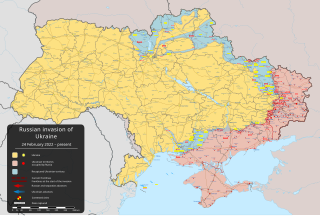Our website is made possible by displaying online advertisements to our visitors.
Please consider supporting us by disabling your ad blocker.
Russian invasion of Ukraine
This article needs to be updated. (January 2025) |
| 2022 Russian invasion of Ukraine | |||||||
|---|---|---|---|---|---|---|---|
| Part of the Russo-Ukrainian War | |||||||
 Military situation as of 17 January 2025 Land controlled by Ukraine Land controlled by Russia Land recaptured by Ukraine from Russia | |||||||
| |||||||
| Belligerents | |||||||
|
Supported by: |
| ||||||
| Commanders and leaders | |||||||
| Strength | |||||||
| |||||||
| Casualties and losses | |||||||
| |||||||
On 24 February 2022, Russia invaded Ukraine. The invasion is causing thousands of deaths every month (as of 2024).
It is part of the Russo-Ukrainian War that started in 2014. The 2022 invasion started after the 2021–2022 Russo-Ukrainian crisis. Russia supported the Donetsk People's Republic and the Luhansk People's Republic in the months before the invasion.
More Russian soldiers came to the Donbas region of eastern Ukraine on 21 February 2022. The invasion was condemned by many countries. In Russia, many opposition groups formed anti-war protests. Many of the protesters were arrested by the Russian government.[23][24]
Millions of refugees fled to western Ukraine or to Poland and other foreign countries. Many foreign countries denounced the invasion. On 2 March 2022, United Nations General Assembly Resolution ES-11/1 demanded that Russia take its troops out of Ukraine.
Background: In 1994, the security agreement, "The Budapest Memorandum (picture) was signed"; Furthermore, it was signed by authorities from the United States, the United Kingdom, and the Russian Federation; Those authorities "promised to [protect or] safeguard Ukraine’s sovereignty in exchange for [Ukraine giving or] surrendering nuclear weapons" to Russia.[25]
Cite error: There are <ref group=lower-alpha> tags or {{efn}} templates on this page, but the references will not show without a {{reflist|group=lower-alpha}} template or {{notelist}} template (see the help page).
- ↑ Lister, Tim; Kesa, Julia (February 24, 2022). "Ukraine says it was attacked through Russian, Belarus and Crimea borders". Kyiv: CNN. Archived from the original on February 24, 2022. Retrieved February 24, 2022.
- ↑ Murphy, Palu (February 24, 2022). "Troops and military vehicles have entered Ukraine from Belarus". CNN. Archived from the original on February 23, 2022. Retrieved February 24, 2022.
- ↑ Rodionov, Maxim; Balmforth, Tom (February 25, 2022). "Belarusian troops could be used in operation against Ukraine if needed, Lukashenko says". Reuters. Archived from the original on February 25, 2022. Retrieved February 25, 2022.
- ↑ "Missiles launched into Ukraine from Belarus". BBC News. February 27, 2022. Archived from the original on March 2, 2022. Retrieved February 27, 2022.
- ↑ Barnes, Julian E.; Crowley, Michael; Schmitt, Eric (January 10, 2022). "Russia Positioning Helicopters, in Possible Sign of Ukraine Plans". The New York Times. Archived from the original on January 22, 2022. Retrieved January 20, 2022.
- ↑ Bengali, Shashank (February 18, 2022). "The U.S. says Russia's troop buildup could be as high as 190,000 in and near Ukraine". The New York Times. Archived from the original on February 18, 2022. Retrieved February 18, 2022.
- ↑ 7.0 7.1 Hackett, James, ed. (February 2021). The Military Balance 2021 (1st ed.). Abingdon, Oxfordshire: International Institute for Strategic Studies. ISBN 978-1-03-201227-8. OCLC 1292198893. OL 32226712M.
- ↑ The Military Balance 2022. International Institute for Strategic Studies. February 2022. ISBN 9781000620030 – via Google Books.
- ↑ https://www.yahoo.com/news/moscow-says-ukrainian-casualties-exceed-084214040.html?guccounter=1&guce_referrer=aHR0cHM6Ly93d3cuZ29vZ2xlLmNvbS8&guce_referrer_sig=AQAAAIeqHakAEv9YqjqcW4jFmNPh76Bz8H5Lgd5h4u7ZWzKmst77OuvCEQzNwE3ielrnKKI8AdHqXDAxKh6h2CGGUcZkhVrQmie4hbMGsFFWxp9GVzGJy7JLbARND0HWgf8w85W9Ma_ppt4XBEhGKFUWsW1bvwfqAVd3y5O0c5mQQqIY
- ↑ https://semnasem.org/articles/2023/08/01/spisok-zhertv-vojny-v-rossijskih-regionah
- ↑ https://www.ohchr.org/en/news/2023/07/ukraine-civilian-casualties-24-february-2022-30-june-2023
- ↑ https://konkretno.ru/veteran/154562-novye-territorii-svo-itogi-avgusta.html
- ↑ https://konkretno.ru/veteran/154562-novye-territorii-svo-itogi-avgusta.html
- ↑ https://dan-news.ru/emergencies/terroristicheskie-obstrely-s-17-fevralja-2022-unesli-zhizni-4832-mirnyh-zhitelej/
- ↑ https://lug-info.com/en/news/3-200-lpr-civilians-killed-as-a-result-of-kiev-s-aggression-since-2014-ombudsperson
- ↑ https://lug-info.com/en/news/kiev-artillery-attacks-claim-72-lives-in-lpr-over-year-268-people-wounded-ombudsperson
- ↑ https://www.yahoo.com/news/moscow-says-ukrainian-casualties-exceed-084214040.html?guccounter=1&guce_referrer=aHR0cHM6Ly93d3cuZ29vZ2xlLmNvbS8&guce_referrer_sig=AQAAAIeqHakAEv9YqjqcW4jFmNPh76Bz8H5Lgd5h4u7ZWzKmst77OuvCEQzNwE3ielrnKKI8AdHqXDAxKh6h2CGGUcZkhVrQmie4hbMGsFFWxp9GVzGJy7JLbARND0HWgf8w85W9Ma_ppt4XBEhGKFUWsW1bvwfqAVd3y5O0c5mQQqIY
- ↑ https://www.usnews.com/news/world/articles/2023-01-17/over-9-000-civilians-killed-in-ukraine-since-russia-invaded-kyiv
- ↑ https://kyivindependent.com/minister-russian-forces-kill-2-000-civilians-in-2023/
- ↑ https://www.slovoidilo.ua/2023/10/05/novyna/suspilstvo/nazvana-kilkist-znyklyx-bezvisty-ukrayinskyx-vijskovyx
- ↑ https://www.kyivpost.com/post/25207
- ↑ https://www.gov.pl/web/diplomacy/statement-on-summoning-the-ambassador-of-the-russian-federation-to-polish-mfa
- ↑ Morin, Rebecca (February 24, 2022). "World leaders condemn Russian invasion of Ukraine; EU promises 'harshest' sanctions – live updates". USA Today. Archived from the original on February 24, 2022. Retrieved February 24, 2022.
- ↑ "More than 1,700 people detained in widespread Russian protests against Ukraine invasion". CBC News. February 24, 2022. Archived from the original on February 24, 2022. Retrieved February 24, 2022.
- ↑ https://www.kyivpost.com/post/43393. Retrieved 2024-12-06
Previous Page Next Page
Russiese inval in Oekraïne sedert 2022 AF ዘረኝነት በሩሶ-ዩክሬንያን ጦርነት AM Invasión rusa d'Ucraína de 2022 AN 2022 infaru Russlandes on Ucrægnan ANG الغزو الروسي لأوكرانيا Arabic جتياح روسي د ؤكرانيا د 2022 ARY الغزو الروسى لاوكرانيا (2022) ARZ ইউক্ৰেইনৰ ওপৰত ৰাছিয়াৰ আক্ৰমণ AS Invasión rusa d'Ucraína de 2022 AST Rusiya–Ukrayna müharibəsi (2022–hal-hazırda) AZ


